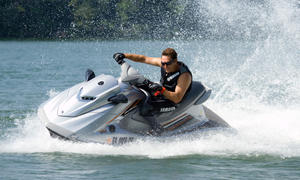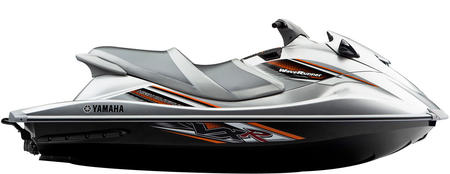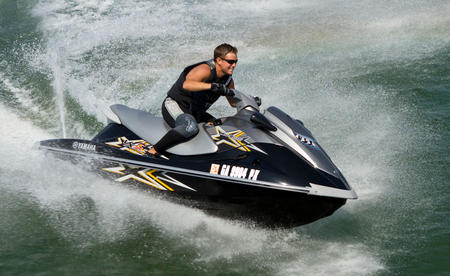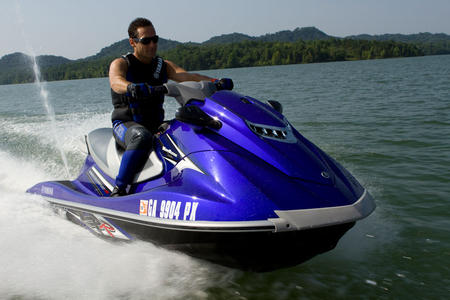2011 Yamaha VXS/VXR Preview
Big power wrapped in a lightweight and affordable package
Yamaha is going back to the performance basics for 2011, focusing on power-to-weight ratio by throwing a gutsy, large displacement motor into a lightweight and agile hull. Sure, all portions of the equation are familiar — that engine is the 1.8-liter mill, sans supercharger and intercooler, shared by the FZ series and the hull is the familiar design shared by three existing VX models. The end result, however, is a craft that early reports claim is a high-performance beast sporting a cheaper boat’s price tag.
A Yamaha rep hinted at the new VXR and VXS back in late Spring, when he told me the company was going to kind of go back to the basics for 2011, concentrating on a model that was fast and fun, but less expensive. By the company’s late August dealer meeting, many were speculating that the craft in question would in fact be a VX derivative. It’s always been a fun and agile hull design that seemed to have potential beyond its role as an introductory model. Design tweaks for 2010 appeared to make it even better, but Yamaha reps now confirm those tweaks were also paving the way for the 1.8-liter engine design.
AS previously mentioned, it’s the same 1.8-liter used in the FZ models, a compact design that makes its power through brute displacement. In lighter vehicles, it can forego the addition of a supercharger and still produce impressive top speed. The VX hull was already a relative lightweight (the best-selling VX Deluxe weighs only 743 pounds total). By switching to NanoXcel, Yamaha’s composite, nanotechnology-derived material that is lighter and stronger than conventional fiberglass or plastic materials previously used, the company has trimmed even more of that waistline.
 Even with the bigger engine, the VXR is nearly 20 pounds lighter than the VX Deluxe.
Even with the bigger engine, the VXR is nearly 20 pounds lighter than the VX Deluxe.Published stats put the VXR at 728 pounds, nearly 20 pounds less than the VX Deluxe. Meanwhile horsepower, though not publicly revealed by Yamaha, would appear to be around 180. Nearly anyone can do that math. Early reports have put the boat’s top speed easily beyond the 65 mph mark with a solo passenger (68+mph is the rumored peak), while acceleration times appear to be on par with the FZs at about a 1.8-second time from 0-30 mph. I’ll be verifying results personally in several weeks.
Like the FZR and FZS, the new model has two different monikers. The least expensive VXS will cost $10,899 and be available in black, with a somewhat conventional three-passenger, stepped saddle. The more performance-slanted VXR will have a lower slung, more even seat to allow riders to scramble around for better leverage, along with a choice of metallic blue or silver paint for $11,199.
So let’s bring things full circle to the company’s original goal — high-performance power for a cheaper boat’s price tag. The FZR and FZS feature that same engine, but require a supercharger to reach similar performance numbers. I think the FZ hull is likely a more pure performance design, but the boats share a $13,399 price tag, a more than $2,000 premium over the VXS. Privately, I’ve heard that dealers have been enthusiastic about the two models, obviously feeling that top-of-the-line musclecraft speed at a midrange price is going to prove popular with consumers. Personally, I’ll be curious to feel the quality of the ride en route to those speeds with so much power in such a lightweight boat, but think the boats will prove a hit.
There’s a lust for speed in this market, and the VXR and VXS may have just satisfied it at a fraction of the previous cost.
Related Reading
Yamaha unveils new VXR and VXS
2010 Yamaha FZR Review
2010 Yamaha VX Deluxe Review
2010 Yamaha VX Sport Review
Get PersonalWatercraft.com in your Inbox!
Like PersonalWatercraft.com on Facebook
Comments
Most Popular

2025 Yamaha JetBlaster PRO 2-Up Review

2024 Kawasaki Jet Ski STX 160X Review

Remembering the Sea-Doo XP

Whatever Happened to the Wetbike?

2025 Yamaha JetBlaster Review














 Your Privacy Choices
Your Privacy Choices